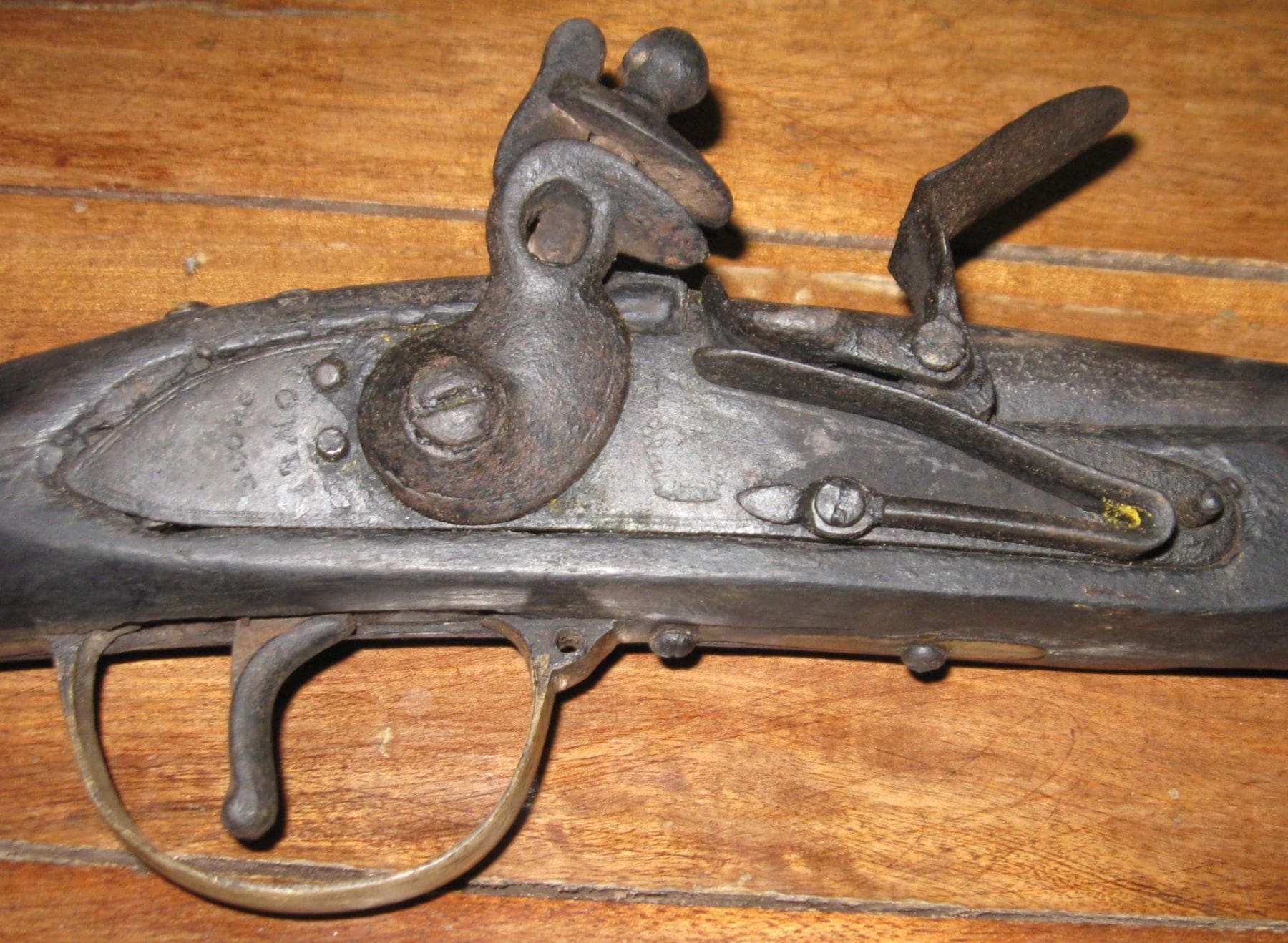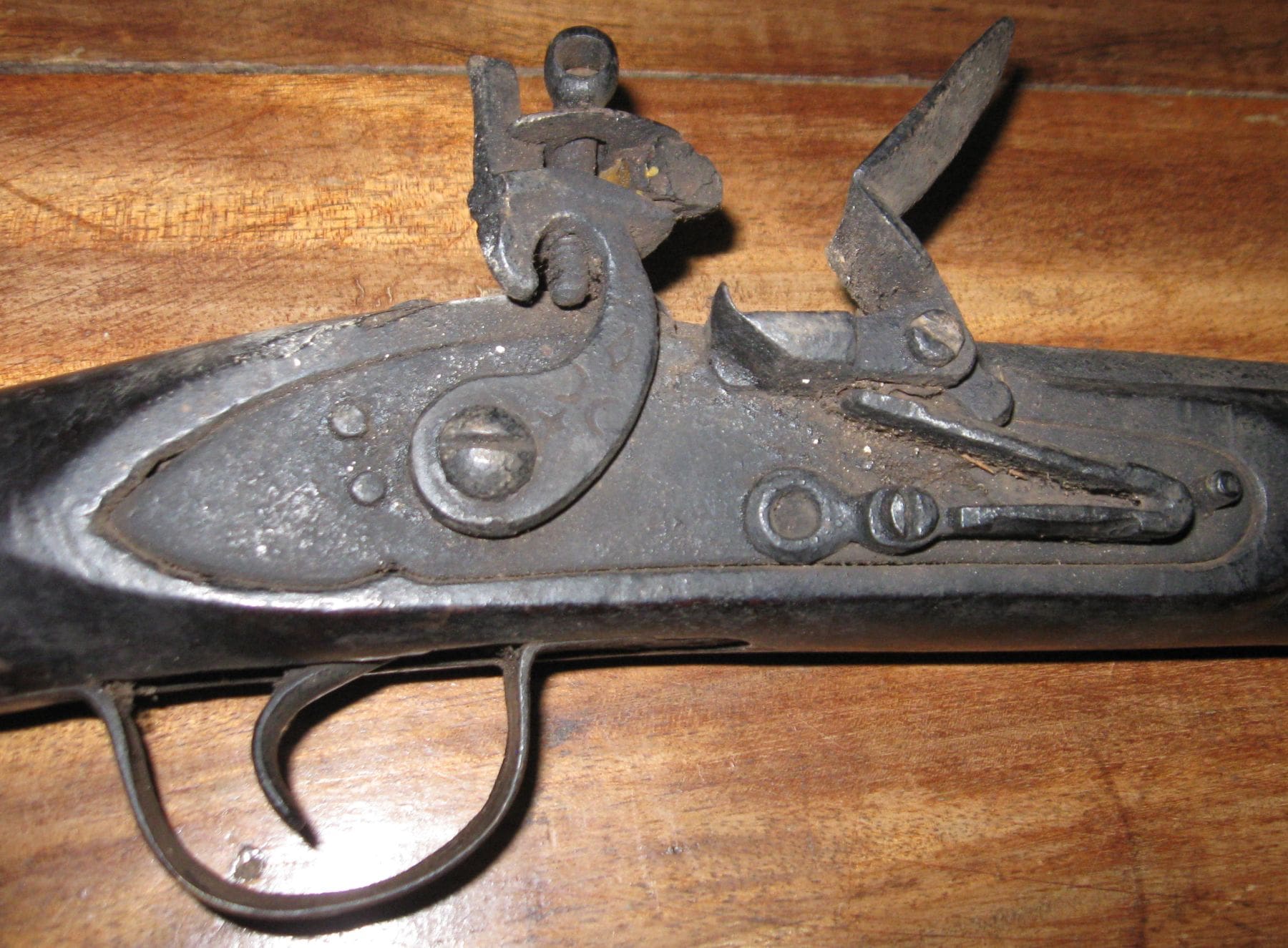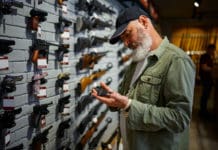By Lance F.
My family and I are missionaries in Africa and I am a regular reader of TTAG when the internet allows. My two favorite hobbies are hunting and guns. Since I have not been able to pursue my gun hobby and will never get to hunt here, my wife was more then supportive last Monday when I had the opportunity to buy two flintlock muskets . . .
These muskets have survived quite well considering the hot humid climate they have been in for many years. One of them is a Brown Bess, the musket used by the British army in all of their wars from 1728 to 1854. It was also used by the East India Company. The Brown Bess was used by other countries during this time also, most notably the American war for independence (on both sides), the War of 1812 (again on both sides) and the Texan war for independence by the Mexican army.
This particular musket has a 39 inch barrel with an over all length of 56 inches. This means it is probably a New Land Pattern firearm, tough it does not match any Pattern perfectly. Production of the New Land Pattern started in 1802 and continued to 1839 as a flintlock configuration.
The emblem behind the barrel embedded in the stock is missing so I can not definitively say that it is not an East India Company musket. The stock is beat up but the lock functions and the barrel is in decent order. There is some pitting inside but not enough to compromise the barrel. The ramrod is rusted off short and the flint is missing. The gun shoulders well and points almost as nicely as my 870. It probably has been used mostly as a shotgun here in Africa.
Now the real challenge; the other musket has a 21″ barrel with an over all length 38 and 3/8 inches, and it looks to be about .69 caliber, which was the French standard for their Charleville muskets. It has one barrel band near the end. On the hammer is an arrow head pointing up, under that, two half moons with the open ends facing out, and then under that a four pointed star.
The star and half moons are repeated on the trigger guard behind it on the flat tang. It points horribly, it is impossible to get your eye down far enough to look down the barrel and use the bayonet lug as a sight. It seems like it was made in this short length and was not cut down at some later point. The barrel has a lot of rust inside and it even has a small hole 4 inches from the lock, so I will not be firing this gun. The lock functions but is sluggish. I have a guess but I am not certain of what it is. Can any of you help identify this musket?
Now I need to make some black powder and find something to use as shot so I can test fire the Brown Bess. I have heard that the Africans use the seeds of a certain fruit as shot. I will try to find out more about this. I wish that guns could talk and tell us their stories, how they came to Africa and what has happened to them over the years.








DO NOT shoot these muskets!!!!!!!!!!!!!!!!!!!!! These are NOT in good shape, and you will end up blowing them apart. I doubt seriously if the lock work would even function properly. Why would you even attempt to fire these? This is truly a case of “…thinking…” Which is what I tell people NOT to do.
Guns are made to be shot. As soon as you stop shooting them they are no longer guns.
If the gun is not safe to shoot, don’t shoot it. Get it serviced and in working order first. THEN shoot it.
+1 safety first…unless you have access to an X-ray machine, there isn’t any way to see if there are minuscule stress cracks or fractures in the action or barrels. Bad news for the guns and you if you decide to go ahead and shoot them. They will look nice on your mantel though. The shorter one appears to be an early British colonial musketoon/carbine ca. early 19th century they were often seen in .69 cal. The half moon thingies may be Arabic or Persian cartouches…
Good point on taking it to an X-ray. I might be able to do that. Also I am not an idiot. The statement about the seeds was tongue in cheek and is an anthropological interest. It has been shot recently, however don’t plan doing anything more then flashing the pan and having a small bang inside. I don’t plan on loading anything in it.
For the record, I don’t think you’re an idiot brother. Just be careful 🙂
Really interesting article!
It would be nice to know the history of these two weapons but unless they are sitting in a museum little chance of that. But you are free to use your imagination, and that could be a lot of fun!
Shame other counties do not have laws allowing use of these wonderful old guns.
I will pray for you in your missionary work. I love to read about my brothers and sisters out spreading the gospel.
God bless
Lance, great collectibles and great curios and reminders of your adventures in Africa. Is it possible that these muskets were locally made like the Khyber Pass copies of famous firearms?
I live in Cameroon. I don’t believe they could have been copied here. Somewhere in Africa…maybe. The people here would have put their own symbols on the lock and not have copied the British ones. The stock on the Bess is definitely 200 years old (give or take a few). I have worked as a carpenter a lot and have some experience telling the age of wood. Also the iron has been russeted and varnished. The blacksmiths here could not have done russeting 200 years ago. So I think it is genuine. Many East India company muskets were sold to the British military for the Egyptian campaign. So it could have traveled across the continent from there. Or a ship trading along the coast could have sold/traded it here in West Africa. Both theory’s seem to say it is an EIC gun and not a New Land Pattern, but it seems to be closer to the NLP then the EIC guns.
The other musket is probably a late 1800’s copy of a Charleville musket. My guess is Turkey, but It could have bean anywhere in the Middle east. It does not have either varnish or russeting on the iron, and that is why it is in such poor condition, and probably a copy of something.
Pieces of history — and unlocking the secret of these muskets (pun intended) is part of the fun.
I’d clean that Bess up, load it up, tie it to an old tire and fire it with a long string. If it works after firing a double charge I would be comfortable shooting light loads out of it.
Guns are for shooting.
It looks as if the Bess has had the lock replaced. I would not fire them, but save them as relics and hierlooms
You do understand that both of these flintlocks qualify as “assault weapons”, because they were both issue-firearms used by front-line infantry soldiers. Plus, they were capable of mounting the DREADED bayonet!
As such, you will probably be arrested by the TSA firearms experts when you attempt to bring these into the US. [sarc/off – maybe]
Well the itinerant morons have struck once again. Shooting these things is at best dangerous, given their age and condition. But then given the I.Q. of most of you arm chair warrior wannabes, it only makes sense that YOU would load these up to shoot. It is no wonder that the anti’s keep on with the asault upon our rights with idiots like this, saying ” I would shoot them, and guns are for shooting.” With advice like that, it’s truly a wonder you dope bags are still breathing air!
And you believe yourself to be so superior somehow. By acting tough on the internet and putting some people down?
For the record, I wouldn’t shoot those either.
Or you could read what the author said in the comments above about it only being shot without a round in the barrel.
I think that musketoon was probably made in Turkey or Persia. The stamps look kinda familiar, I’ll dig through my older books and see if I can find anything for you. And don’t clean them! Get them home and to an appraiser before doing any cleaning, and preferably let said appraiser do that.
Just an enthusiast’s opinion off a few photos…
Are you sure the first is an EIC musket and not a trade musket from the late 1800’s? The few EIC muskets I’ve seen used either EIC within a heart or the EIC rampant lion logo instead of the British crown marking because the EIC was a private corporation. The crown without a V.R. or G.R. marking along with the tower marking makes me think it is a commercial trade gun from the late 1800’s. In the late 1800’s the European countries placed the musket parts from the first half of the century on the surplus market, so a lot of enterprising people put the parts together for sale in Africa and Asia where muskets kept a strong market share, meaning that a lot of old parts ended up on new muskets or as some mix thereof. If it was ever British military issued it should have a broad arrow marking somewhere.
I would think the second is also a British trade musket from the latter half of the 1800’s that has been cut down at some point. After the French took control of Algeria in the 1830’s they really dominated the musket trade with the interior, so their main competitors the British and the Turks tried to sell muskets that conformed with the French muskets to take market share away from the French. The star and crescent are Muslim symbols, but the 8 pointed star is important to Muslims, not a 4 pointed one. I would think a Turk would know that and that the markings were probably added in a factory in England.
Hey, thanks for the information. I have been looking all over for a G.R. or a V.R. and have not found them. The crown is low on the lock and so there is not the usual room underneath for the marks. There are the standard marks on the barrel too but I did not send photos of them. Can you point me to a good picture of the broad arrow marking so I know what to look for?
I do not believe the shorter one was cut down, but came from the maker short like that. You are correct that the star is not a Muslim star.
The British took over this part of Africa after WW1, a British governor could have had them imported for sale/trade/use that that point.
Hey, I been going through my older books to find anything I could on these markings, and you appear to have hit on one point. A lot flintlocks were made for trade in the colonial market in the mid-1800s. What today we call after market knockoffs, built from a combination of original and newer parts. I found a couple of pics of Brown Bess pattern muskets with non typical markings in, of all places, an old Encyclopedia Britannica. Could not get a digital image clear enough to post, though.
The crescents and star stamp does not match any I can find. Does not rule out it being made in Turkey or Persia, since both were sources of “after market” fire arms, as well as their own unique designs by makers, some of who are still in business today.
I’ll keep looking, but these may fall into the unidentifiable category. Although from their age and location found they are still quite collectible.
Normally the broad arrow is under the pan. You can try this site to get an idea; they sell guns out of Nepal. They ask more for the British made/issued ones which should have the broad arrow.
http://www.ima-usa.com/
Thanks for the link! Ashamed to say I never heard of these guys.
Thanks for the site. I saw a good example. I can not find any trace of either the arrow or GR markings, but it does have the Crown, Tower, and Proof markings, interesting. I guess it was probably stored at the Tower and then later sold as a trade musket in Africa, possibly having been put together from parts to be sold. Thank you for your help guys.
Comments are closed.